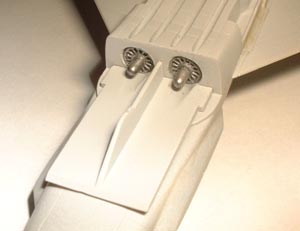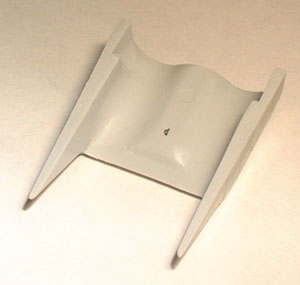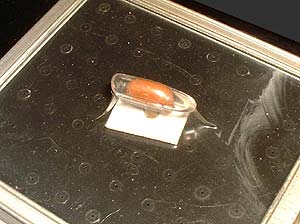| Revell 1/144th MiG 1.44 |
| |
 |
|
| I get the feeling the engineers at the Mikoyan Design Bureau
are Gerry Anderson fans as this thing looks like it's straight out of Captain
Scarlet or the Thunderbirds. The MiG 1.44 MFI (Multifunction Fighter) is
a technology and airframe/ propulsion concept demonstrator developed in
response to US projects that ultimately led to the F-22. It was rolled out
for the public on January 12, 1999 (my 34th birthday!) and first flew on
February 29, 2000 with Vladimir Gorbunov at the controls. Powered by thrust
vectoring Lyulka-Saturn AL-41 engines it has a greater range than the Su-27
and supercruise (supersonic flight without using afterburners) capability.
( AIR Pictorial Aug. 2000; p.509 ) |
| |
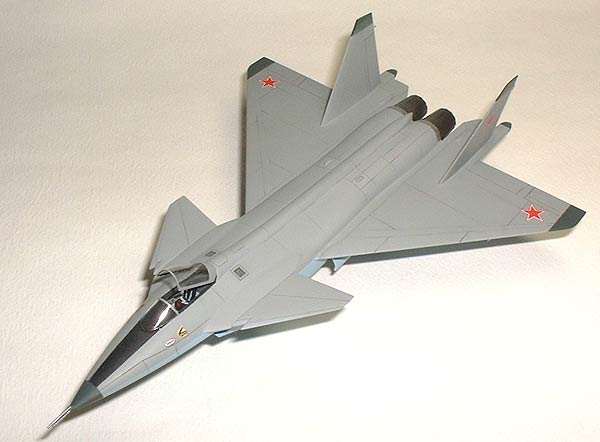 |
|
| This isn't one of Revell's better efforts I have to say. Fit
left a lot to be desired and a lot of filling and sanding was required at
the wing roots, vertical stabilisers and canard fairings. There are a few
outline errors as well mainly concerning the bottom of the air intake which
should be curved when viewed from the front and more angular to the rear
between the nose and main wheel wells. It's certainly close enough for me
and hats off to Revell for producing this relatively obscure subject anyway. |
| |
 |
|
| I didn't originally intend to open the canopy but I felt the
kit item was far too thick and I needed an excuse to finally use that Mattel
Vacu-former that's been sitting around so I moulded a new one. Three attempts
gave me one good windscreen and one good canopy so I cut them apart and
glued the canopy in the open position. |
| |
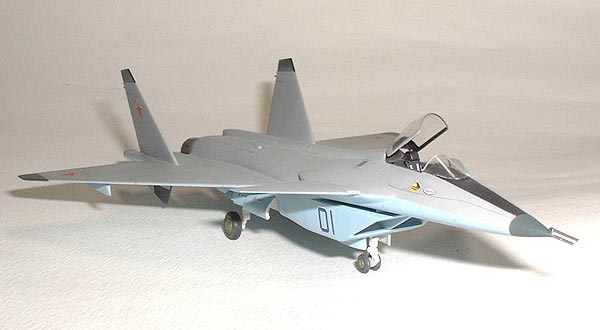 |
|
| My only other modification was to stick some engine fans in
that gaping air intake. 1/144th jet engines aren't exactly thick on the
ground so I had to improvise a bit. Mine were made from two leftover 1/72nd
Hasegawa Tomcat wheels with the hubs made from the little generator fans
from a 1/72nd Prowler's ECM pods. It's nowhere near accurate I'm sure but
at least it doesn't look like a big empty box now. |
| |
 |
|
| Paint is Polly Scale British Sea Grey Medium which looks pretty
close to the few pictures I could find on the net of this thing. The bottom
is a mix of Polly Scale RLM 76 and Light Gray and the radome and dielectric
panels are a Humbrol dark green/ dark gray mix. The tops of the fins look
pretty faded and weathered in pictures (which is odd because the aircraft
was brand spanking new at the time) so I sanded these lightly to depict
that. Exhausts are done in various shades of Testors Metalizer and the data
probes on the nose are brush painted with Metalizer Stainless Steel. You're
not supposed to be able to brush Metalizer but it actually works quite well
as long as you work quickly and apply it in one pass. |
| |
 |
|
| I had a moment of temporary insanity when the MiG was nearly
finished: I left the door to the modelling haven open while I went downstairs
for a bite to eat. At this point my faithful furry friend took the opportunity
to have a look out the window over my workbench, apparently unconcerned
that the model he was standing on wasn't designed to hold a 15 pound feline.
I did my best to fix the broken landing gear legs but they'll just never
be quite the same. Lesson learned; never leave the sanctuary unguarded.... |
| |
 |
|
| For a single seat fighter this is one large airplane. It dwarfs
the other 1/144th models in my display case and is longer than my 1/72nd
scale Bearcat
racer. |
| |
 |
|
| |
|
|
|
| Above left & right:
Scratchbuilt engine faces and the lower intake half which has been smoothed
out with Milliput. |
|
Above left: My first attempt
at vac-forming with the trusty Mattel Vacu-former. What a great little machine.
Toys were so much cooler in the sixties when people didn't get all uptight
about burnt fingers and litigation!
Above right: I wouldn't normally bother
detailing a 1/144th scale seat but since the canopy is open I thought I'd
add the harness and ejection handle. Frankly, I'm impressed that Revell
add any cockpit detail at all in this scale. |
| |
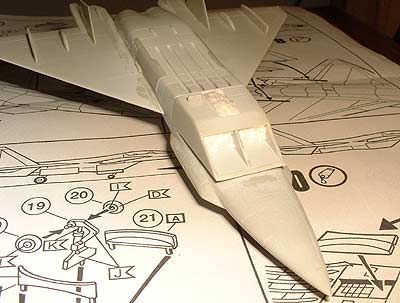 |
|
| |
See?? I do use the instructions.... |
|
|
| |
 Back to 1/144th main Back to 1/144th main |
| |








